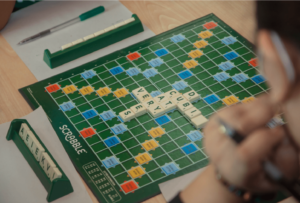
Game-Based Learning Examples
How can you use game-based learning in teaching the English language? Learning a new language can be difficult if learners are not interested in it or do not see its value. However, there is a teaching method that can make language learning more fun, interactive, and meaningful: game!
Game-based learning is a type of experiential learning that uses games to engage learners and facilitate the acquisition of knowledge and skills. Its environment uses educational games to engage students, provide immediate feedback, and encourage them to compete healthily. All so that while students play, they stay motivated to learn.
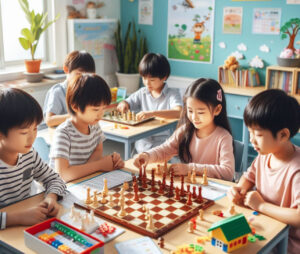
Importantly, use different types of games for game-based learning, depending on the purpose, context, and level. Some examples are:
- Board games. These are games that involve moving pieces on a board according to rules. For example, teachers can use games like Scrabble, Boggle, or Pictionary to teach vocabulary, spelling, and word formation.
- Card games. They involve using cards with different symbols, numbers, or words. Specifically, teachers can use games like Uno, Go Fish, or Memory to teach colors, numbers, and matching skills.
- Role-playing games. These are games that involve acting out different scenarios or characters. For instance, teachers can use games like Charades, Guess Who, or 20 Questions to teach verbs, adjectives, and questions.
In this article, you will learn some specific examples of games to teach different English skills, such as vocabulary, grammar, reading, writing, listening, and speaking. Also, you will learn how the game works, the learning objectives, the outcomes, and how the teacher can facilitate and assess the learning process.
Vocabulary: Scrabble
Scrabble is a board game that involves forming words with letter tiles on a grid. Participants’ scores on the length and difficulty of the vocabulary they form. Also, players can use bonus squares on the board to multiply their scores.
Similarly, you can use Scrabble to teach vocabulary related to different topics, such as animals, plants, food, clothing, colors, and shapes. Teachers can create custom word lists for the students to use during the game. For example, teachers can create word lists about animals or food for the students to practice. Or they can create word lists about clothing or colors for the students to learn new words.
The learning objectives of using Scrabble for vocabulary are to:
- Expand your language in a specific area
- Practice spelling and pronunciation of the words
- Use the words in meaningful sentences and contexts
The learning outcomes of using Scrabble for vocabulary are the following:
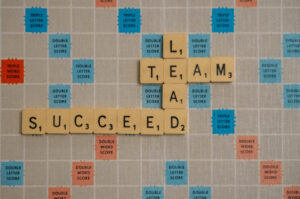
At the end of the lesson, the students will be able to:
- Recognize and recall the words;
- Use the words appropriately and accurately;
- Expand their vocabulary range and depth.
The teacher’s role in using Scrabble for vocabulary is to:
- Provide and explain the word lists for the students;
- Monitor and guide the student’s progress and performance;
- Provide feedback and correction when needed;
- Assess the students’ learning outcomes using quizzes or rubrics.
Grammar: GoFish
It is a card game that involves asking and answering questions about cards in one’s hand or a pile. Players try to gather groups of four cards of the exact level by asking other players if they have them. If they do, they give them to the asker. However, if they don’t, they say, “Go fish,” and the one who asks pulls a card from the pile.
GoFish can be used to teach grammar rules and patterns interactively. Teachers can create custom cards with different grammar topics, such as verb tenses, noun genders, sentence structures, and word order. For example, teachers can create cards with verbs in different tenses for the students to practice. Or they can make cards with nouns of different genders for the students to learn.
The learning objectives of using Go Fish for grammar are to:
- Learn new grammar rules and patterns;
- Practice applying the rules and patterns in different questions and answers;
- Review and reinforce the rules and habits over time.
The learning outcomes of using Go Fish for grammar are:
At the end of the lesson, the students can:
- Understand and explain the grammar rules and patterns;
- Use the grammar rules and practices correctly and confidently;
- Improve their grammar accuracy and fluency.
The teacher’s role in using Go Fish for grammar is to:
- Create and distribute the custom cards for the students;
- Track the student’s progress and performance;
- Provide additional explanations and examples when needed;
- Assess the students’ learning outcomes using tests or portfolios
Reading: Pictionary
Pictionary is a board game that involves drawing and guessing words or phrases. Players take turns illustrating words or phrases while their teammates try to identify the hidden meanings. The group with the highest score at the end of the match wins.
Pictionary can be used to teach reading comprehension and analysis skills in a fun and engaging way. Teachers can create custom cards with different texts, such as narratives, descriptions, instructions, letters, and reviews. For example, teachers can create cards with stories for the students to draw and guess. Or they can make cards with instructions or reviews for the students to read and follow.
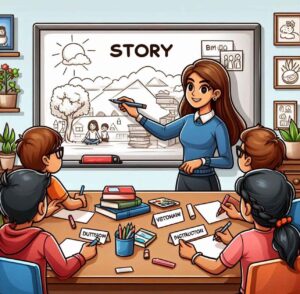
The learning objectives of using Pictionary for reading are to:
- Read for different purposes, such as enjoyment, information, and problem-solving;
- Use different strategies, such as skimming, scanning, and summarizing, to understand the text;
- Answer different types of questions, such as literal, inferential, and evaluative, to demonstrate comprehension
The learning outcomes of using Pictionary for reading are:
At the end of the lesson, the students can:
- Read fluently and accurately;
- Comprehend and analyze the text;
- Apply their reading skills to other subjects and situations.
The teacher’s role in using Pictionary for reading is to:
- Provide and explain the custom cards for the students;
- Monitor and support the student’s progress and performance;
- Provide feedback and correction when needed;
- Assess the students’ learning outcomes using reports or rubrics.
Writing: Charades
Charades is a game that involves acting out words or phrases without speaking. Players alternately act out a word or phrase on a card while their teammates try to guess what it is. The team that scores the most points by correctly playing a hunch of words or phrases wins.
Teachers can use the game as a stimulus for various writing tasks, such as narratives, descriptions, instructions, letters, and reviews. For instance, lecturers can request students to write a story about the word or phrase they acted out, a description of how they acted it out, an instruction manual for playing the game, a letter from one player to another, or a review of the game.
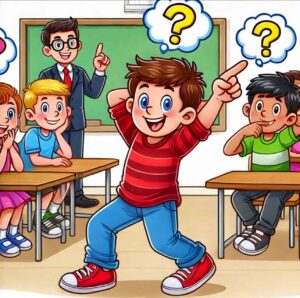
The learning objectives of using Charades for writing are:
- Write for different purposes, audiences, and genres;
- Use various features of writing, such as vocabulary, grammar, punctuation, and spelling;
- To use different stages of writing, such as planning, drafting, revising, and editing
The learning outcomes of using Charades for writing are:
At the end of the lesson, the students can:
- Write effectively and creatively;
- Use appropriate language and style for their writing;
- Improve their writing skills and confidence.
The teacher’s role in using Charades for writing is to:
- Provide and model the writing tasks for the students;
- Guide and scaffold the students’ writing process;
- Provide feedback and correction when needed;
- Assess the students’ learning outcomes using checklists or rubrics
Listening: 20 Questions
20 Questions is a game that involves asking and answering yes or no questions about an object or a person. One player is the “thinker,” and the other players are the “guessers.” The thinker chooses an object or person, and the guessers try to guess what it is by asking up to 20 questions. The player who thinks of the object or person can only answer yes or no.
Moreover, you can use it to teach listening skills socially and interactively. Teachers can use the game as an opportunity for students to practice listening for different purposes, such as information, persuasion, and entertainment. For example, teachers can ask students to listen for clues about the object or person, for arguments about why they should choose the questions, or listen for jokes and reactions from other players.
The learning objectives of using 20 Questions for listening are to:
- Listen for specific details or main ideas;
- To listen for opinions or emotions;
- Listen for tone or intention.
The learning outcomes of using 20 Questions for listening are:
At the end of the lesson, the students can:
- Comprehend and respond to what they hear;
- Express their views and feelings;
- Improve their listening skills and strategies.
The teacher’s role in using 20 Questions for listening is to:
- Set up and join the game with the students;
- Facilitate and monitor communication among the students;
- Provide feedback and correction when needed;
- Assess the students’ learning outcomes using quizzes or observations.
Speaking: Guess Who
Guess Who is a board game that involves asking and answering questions about people’s appearance. Each player has a board with 24 faces of different people with different features. Each player also chooses one secretly. Participants take turns to ask yes or no questions about the other player’s chosen face, such as “Does your person have glasses?” or “Is your person bald?”. The aim is to guess the other player’s face before they identify yours.
Playing the Guess Who game is an excellent method to enhance one’s speaking abilities in a fun and effortless way. This game encourages players to describe various characteristics of the characters on the board, such as their physical appearance, clothing, and accessories. It not only improves one’s speaking skills, but it also helps to expand vocabulary, develop logical thinking, and stimulate creativity.
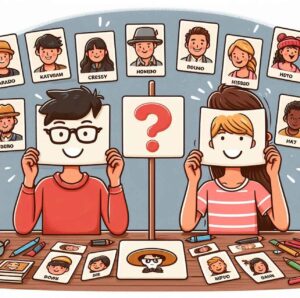
Overall, the Guess Who game is valuable for anyone looking to enhance their communication skills. Educators can use the game to introduce vocabulary related to physical appearances, such as hair, eyes, nose, mouth, ears, glasses, hat, beard, and mustache. Teachers can also use the game to teach grammar related to questions, such as word order, question words, and auxiliary verbs. For example, teachers can ask students to form questions using “do,” “does,” “is,” or “are.”
The learning objectives of using Guess Who for speaking are to:
- Speak for different purposes, such as asking and answering questions;
- To use other features of speaking, such as vocabulary, grammar, pronunciation, and intonation;
- Use different speaking strategies, such as clarifying, paraphrasing, and summarizing.
The learning outcomes of using Guess Who for speaking are:
At the end of the lesson, the students can:
- Speak accurately and fluently;
- Use appropriate language and style for their speaking;
- Improve their speaking skills and confidence.
The teacher’s role in using Guess Who for speaking is to:
- Provide and explain the game boards and rules for the students;
- Elicit and encourage the students to speak during the game;
- Provide feedback and correction when needed;
- Assess the students’ learning outcomes using rubrics or recordings.
Conclusion
In conclusion, game-based learning is an instructional approach that uses games to engage learners and facilitate the acquisition of knowledge and skills. Additionally, you can use this to teach different English skills, such as vocabulary, grammar, reading, writing, listening, and speaking. It can also provide motivation, engagement, and achievement for the students.
However, game-based learning also has challenges, such as finding suitable games, integrating them with the curriculum, managing the classroom dynamics, and evaluating the learning outcomes. Therefore, teachers should be careful and creative when using game-based learning in their classrooms.
Keep in mind the following recommendations for teachers who want to implement game-based learning in their classrooms:
- First, choose relevant, appropriate, and appealing games for your students.
- Second, align the fun with your learning objectives and outcomes.
- Third, provide clear instructions and guidance for your students.
- Fourth, monitor and support your student’s progress and performance.
- Fifth, provide feedback and correction, for your students.
- Sixth, assess your students’ learning outcomes using various methods.
Finally, game-based learning is a promising and exciting teaching method that can make language learning more fun, interactive, and meaningful. Aside from that, games can be a fun and engaging way to help students learn English.
If you have any questions or comments on the Game-Based Learning in Teaching the English Language, feel free to leave them below. Thanks for reading, and I’ll see you at the next one!
References
Robb, K. (2021, September 21). Using social media to engage students. Cambridge English. https://www.cambridge.org/elt/blog/2021/09/21/using-social-media-engage-students/
Sprout Social. (2021, March 26). 12 ways to use social media for education. https://sproutsocial.com/insights/social-media-for-education/
Davis, V. (2014, February 27). A guidebook for social media in the classroom. Edutopia. https://www.edutopia.org/blog/guidebook-social-media-in-classroom-vicki-davis
TeachThought. (2013, December 28). 6 pros & cons of social media in the classroom. https://www.teachthought.com/technology/6-pros-cons-social-media-classroom/



